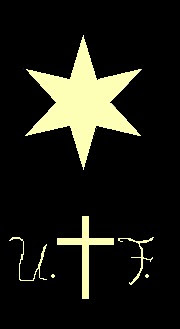Jemima Wilkinson / Publick Universal Friend (Wikimedia Commons)
Jemima Wilkinson (1752-1819) was a queer American preacher who woke from a near-death experience in 1776 believing she was neither male nor female. She changed her name to “the Publick Universal Friend,” fought for gender equality and founded an important religious community.
It’s appropriate to consider the Publick Universal Friend on July 4 for Independence Day. In 1776, the same year that America issued the Declaration of Independence, Wilkinson declared her own independence from gender. This fascinating person died almost 200 years ago today on July 1, 1819.
Wilkinson is recognized as the first American-born woman to found a religious group, but is also called a “transgender evangelist.” The breakaway Quaker preacher spoke against slavery and gave medical care to both sides in the Revolutionary War.
Wilkinson was 24 when she had a severe fever leading to a near-death experience. Upon waking she confidently announced to her surprised family that Jemima Wilkinson had died and her body was now inhabited by a genderless “Spirit of Life from God” sent to preach to the world. She insisted on being called the Publick Universal Friend or simply “the Friend.” From then on, the Friend refused to respond to her birth name or use gendered pronouns.
 |
| Seal of the Universal Friend (Wikimedia Commons) |
Jemima Wilkinson was born to a Quaker family in Rhode Island on Nov. 29, 1752. She showed a strong interest in religion while growing up. On Oct. 13, 1776, the Sunday after being reborn, the Friend gave a public sermon for the first time. Quaker officials rejected the Friend as a heretic, but s/he went on to preach throughout Rhode Island, Massachusetts, Connecticut, and Pennsylvania.
The Friend blended traditional Christian warnings about sin and redemption with Quaker pacifism, abolitionism, plain dress and peaceful relations with Native American Indians. Women had no legal rights in the United States, but the Friend advocated equality of the sexes. The Friend was a firm believer in sexual abstinence.
People were drawn not only to this progressive message, but also to the Friend’s forceful personality and genderbending appearance. S/he rejected standard women’s attire and hairdos for a unique blend of male and female. The Friend commonly wore a flowing black male clergy gown with female petticoats peeking out at the hem. The Friend’s long hair hung loose to the shoulder. The rest of the Friend’s outfit often included a man’s broad-brimmed hat and women’s colorful scarves.
The first recruits were family members, but the Friend soon attracted a diverse group of followers, including intellectual and economic elites as well as the poor and oppressed. Known as the Universal Friends, they upset some people by proclaiming that the Friend was “the Messiah Returned” or “Christ in Female Form.” The Friend did not make such claims directly.
The Friend founded the Society of Universal Friends in 1783. Members pooled their money and started a utopian communal settlement in the wilderness near Seneca Lake in upstate New York in 1788. As the first settlers in the region, they cleared the land and became the first white people to meet and trade with the Native Americans there. By 1790 the community had grown to a population of 260.
Hostile observers put the Friend on trial for blasphemy in 1800, but the court ruled that American courts could not try blasphemy cases due to the separation of church and state in the U.S. constitution. Thus the Friend was a pioneer in establishing freedom of speech and freedom of religion in American law.
Like other isolated utopian communities based on celibacy, the Society of Universal Friends dwindled. The Friend “left time,” as the Universal Friends put it, on July 1, 1819 at age 61. The organization disintegrated within a few years of the founder’s death.
The Publick Universal Friend continues to fascinate people today. One of the most authoritative biographies of this mysterious person is Pioneer Prophetess: Jemima Wilkinson, the Publick Universal Friend
 by Herbert A. Wisbey Jr. In recent years the life and work of the Friend has been examined by feminists and LGBTQ scholars, including gay historian Michael Bronski in his new Lambda Literary Award-winning book, A Queer History of the United States
by Herbert A. Wisbey Jr. In recent years the life and work of the Friend has been examined by feminists and LGBTQ scholars, including gay historian Michael Bronski in his new Lambda Literary Award-winning book, A Queer History of the United States .
.___
Related links:
Chapter on Jemima Wilkinson from “Saints, Sinners and Reformers” by John H. Martin(Crooked Lake Review)
The Assumption of Jemima Wilkinson by Sharon V. Betcher (Journal of Millennial Studies)
Scherer Carriage House (permanent museum exhibit on Jemima Wilkinson)
The Publick Universal Friend – Penn Yan, NY (Exploring the Burned-Over District: Sacred sites in upstate New York)
Leavesofgrass.org
____
This post is part of the GLBT Saints series by Kittredge Cherry at the Jesus in Love Blog. Saints, martyrs, mystics, prophets, witnesses, heroes, holy people, deities and religious figures of special interest to lesbian, gay, bisexual and transgender (LGBT) and queer people and our allies are covered on appropriate dates throughout the year.
